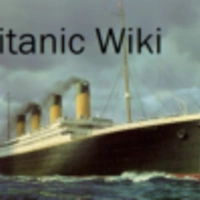
RMS Titanic (colorized image)
RMS Titanic (Royal Mail Steamer "Titanic", sometimes known as SS Titanic) was one of the three passenger liners that were expected to dominate the oversea passenger traffic. She was the property of White Star Line, being built at the Harland and Wolff shipyard.
Size
Titanic was the largest ocean liner in the world at the time, with a tonnage of 46328 BRT.
Other specifications
The Titanic contained two reciprocating four cylinder, triple-expansion, inverted steam engines and one low-pressure Parsons turbine. These powered three propellers. There were 25 double-ended and 4 single-ended Scotch-type boilers fired by 159 coal burning furnaces that made possible a top speed of 23 knots (43 km/h). Only three of the four 63 feet (19 m) tall funnels were functional; the fourth, which served only as a vent, was added to make the ship look more impressive. Titanic could carry a total of 3,547 passengers and crew and, because she carried mail, her name was given the ship prefix Royal Mail Ship (RMS) as well as SS (Steam Ship).
The Titanic was considered a pinnacle of naval architecture and technological achievement, and was thought by The Shipbuilder magazine to be "practically unsinkable."
Titanic had a double-bottom hull, containing 44 tanks for boiler water and ballast to keep the ship safely balanced at sea (later ships also had a double-walled hull). Titanic exceeded the lifeboat standard, with 20 lifeboats (though not enough for all passengers). Titanic was divided into 16 compartments by doors held up, i.e. in the open position, by electro-magnetic latches which could be closed by a switch on the ship's bridge and by a float system installed on the door itself.
Unsurpassed Luxury

The Grand Staircase of the Olympic: Similar to the Titanic's first class section.
For her time, Titanic was unsurpassed in luxury and opulence. She offered an onboard swimming pool, a gymnasium, a Turkish Bath, libraries for each passenger class, and a squash court. First Class common rooms were adorned with elaborate wood panelling, expensive furniture and other elegant decorations. In addition, the Café Parisien offered superb cuisine for the First Class passengers with a sunlit veranda fitted with trellis decorations.
The ship was technologically advanced for the period. She had an extensive electrical subsystem with steam-powered generators and ship-wide electrical wiring feeding electric lights. She also boasted two wireless Marconi radio sets manned by operators who worked in shifts, allowing constant radio contact and the transmission of many passenger messages.
Even Third Class accommodation and common rooms were considered to be as opulent as those in the First Class sections of many other ships of the day. Titanic had three elevators for the use of first-class passengers and, as an innovation, offered one lift for second-class passengers.
Sinking
On her maiden voyage already, she hit an iceberg on Sunday April 14th, 1912 at 11:40 P.M. (the location time), and sank two hours and forty minutes later, at 2:20 A.M.
A Night to Remember.

The New York Herald front page.
About 1517 people perished in tragedy, making it the greatest peacetime marine disasters, being widely known. Titanic used the most modern technology available. They believed she was unsinkable, so you can guess how big shock was this for people, since she (despite the modernity and the experienced crew) did sink in the end, with many dead people.
Two hours after the sinking concluded, RMS Carpathia arrived to the sinking site to help the survivors. Their boarding on the ship extended to 8:30 P.M., when the last lifeboat was picked up. Then she set sail to New York, where she arrived April 18th 1912.
Wreckage
- Main article: Wreck
On September 1st, 1985, Jean-Louis Michel and Robert Ballard descended to the depths of the Atlantic to find the wreckage. The attempt proven successful.
RMS Titanic as the cultural Heritage
Because of the many sinking ship explorers and often items take, June 18th, 2004 was the day when the USA, Canadian, British and French governments decided to leave the wreck alone as the Museum on the Open Space.

Wallace Hartley's violin.
There is possibility to visit the wreckage using the Russian submersible Mir, spending $ 60.000 that way. The time required to arrive to the wreck is approximately one hour.
The violin that belonged to Wallace Hartley was sold in 2013 on the London auction with the price $ 1,6 million.
